How to Set Up Shadowsocks-libev Proxy Server on CentOS/Rocky Linux
This tutorial is going to show you how to set up Shadowsocks proxy server on CentOS. Shadowsocks is a lightweight, fast, and secure Socks5 proxy to bypass Internet censorship. We will learn how to set up the server-side and how to configure the desktop client on CentOS. There are many implementations of Shadowsocks, this tutorial shows you how to use Shadowsocks-libev, because
- It’s written in C, very fast even on low-end box.
- It’s well-maintained.
- It’s the most feature-rich implementation. TCP fast open, multiuser, management API, redirect mode, tunnel mode, UDP relay, AEAD ciphers, and plugins are all supported.
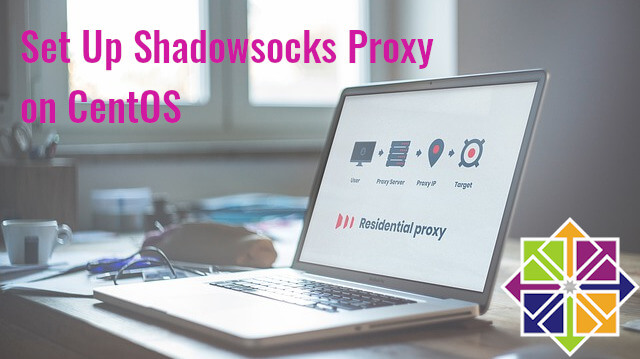
Requirements
To follow this tutorial, you will need a VPS (Virtual Private Server) that can access blocked websites freely (Outside of your country or Internet filtering system). I recommend Kamatera VPS, which features:
- 30 days free trial.
- Starts at $4/month (1GB RAM)
- High-performance KVM-based VPS
- 9 data centers around the world, including the United States, Canada, UK, Germany, The Netherlands, Hong Kong, and Isreal.
Follow the tutorial linked below to create your Linux VPS server at Kamatera.
Once you have a VPS running Ubuntu 24.04, follow the instructions below.
Step 1: Install Shadowsocks-libev Server on CentOS
SSH into your remote CentOS server. Shadowsocks-libev isn’t included in CentOS repository. It’s recommended to install it from the Snap store. To install software from the Snap store, we need to install the snapd daemon.
sudo dnf install -y epel-release sudo dnf update -y sudo dnf install -y snapd
Start and enable the snapd systemd service:
sudo systemctl enable --now snapd.service
Then install Shadowsocks-libev.
sudo snap install shadowsocks-libev
Once it’s installed, you can run the following command show detailed information about the shadowsocks-libev snap.
snap info shadowsocks-libev
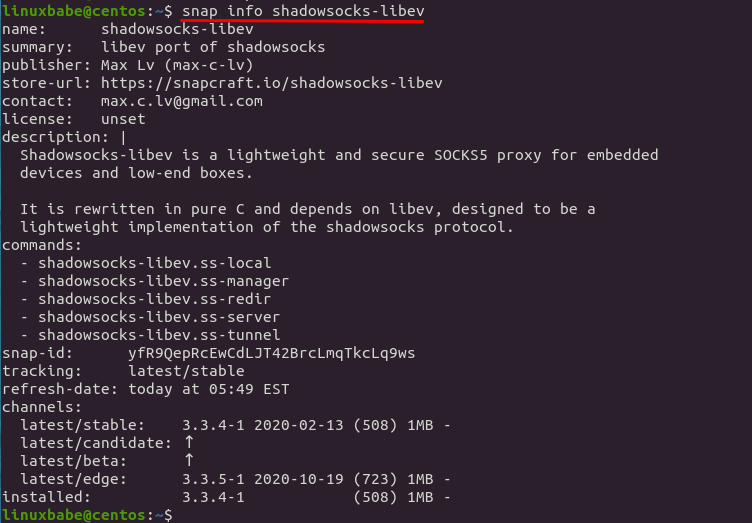
As you can see, there are 5 commands available. Before we use the command to start Shadowsocks-libev server, we need to create a configuration file with a command-line text editor like Nano. Install Nano with:
sudo dnf install nano
Create the configuration file.
sudo nano /var/snap/shadowsocks-libev/common/server-config.json
Add the following lines in this file.
{
"server":["[::0]", "0.0.0.0"],
"mode":"tcp_and_udp",
"server_port":8888,
"local_port":1080,
"password":"o+4LmywwopNXSUhA7Wf8wg==",
"timeout":60,
"name_server":"8.8.8.8",
"method":"chacha20-ietf-poly1305"
}
Where:
server: specify the listening address.[::0]makes it listen on all available IPv6 addresses and0.0.0.0makes it listen on all available IPv4 addresses.mode: Use both TCP and UDP mode.server_port: specify a port that isn’t being used by another process on the server, like 8888.local_port: it’s common to use port 1080 as the local port for SOCKS proxy.password: You can generate a secure random password with this command:openssl rand -base64 16.timeout: 60 seconds.name_server: Shadowsocks can make clients use the specified DNS server like8.8.8.8. You can also change it to1.1.1.1, so clients will be using Cloudflare DNS server.method: sepcify the encryption algorithm.chacha20-ietf-poly1305is a very fast secure algorithm.
Save and close the file. (To save a file in Nano text editor, press Ctrl+O, then press Enter to confirm. To exit, press Ctrl+X.)
Step 2: Run Shadowsocks-libev Server as a Systemd Service
We can manually run the Shadowsocks-libev server, but it’s more convenient to create a systemd service unit for it, so it can be automatically started at boot time. Use the Nano text editor to create a systemd service.
sudo nano /etc/systemd/system/shadowsocks-libev.service
Add the following lines in this file.
[Unit]
Description=Shadowsocks-Libev Server
After=network-online.target
[Service]
Type=simple
ExecStart=/usr/bin/snap run shadowsocks-libev.ss-server -c /var/snap/shadowsocks-libev/common/server-config.json
Restart=always
RestartSec=2
[Install]
WantedBy=multi-user.target
Save and close the file. Then start shadowsocks-libev service.
sudo systemctl start shadowsocks-libev.service
Enable auto-start at boot time.
sudo systemctl enable shadowsocks-libev.service
Check its status. Make sure it’s running.
systemctl status shadowsocks-libev.service

If you made a mistake in your shadowsocks-libev systemd service file, correct your error and reload systemd.
sudo systemctl daemon-reload
Then you can restart shadowsocks-libev service.
sudo systemctl restart shadowsocks-libev.service
If you see the following error.
This system doesn't provide enough entropy to quickly generate high-quality random numbers. The service will not start until enough entropy has been collected.
You can fix this error by installing rng-tools.
sudo dnf install rng-tools
Then run
sudo rngd -r /dev/urandom
Now you can start Shadowsocks-libev service.
Step 3: Configure Firewall
You need to allow traffic to the TCP and UDP port Shadowsocks is listening on. For example, if port 8888 is being used by Shadowsocks, then run the following command:
sudo firewall-cmd --permanent --add-port=8888/tcp sudo firewall-cmd --permanent --add-port=8888/udp
Then reload firewalld for the change to take effect.
sudo systemctl reload firewalld
Step 3: Install and Configure Shadowsocks-libev Client
CentOS Desktop
The shadowsocks-libev package contains both the server software and client software. The Shadowsocks client binary is named ss-local. Use the same method to install it on CentOS desktop.
First, install the snapd daemon.
sudo dnf install -y epel-release sudo dnf update -y sudo dnf install -y snapd
Start and enable the snapd systemd service:
sudo systemctl enable --now snapd.service
Then install Shadowsocks-libev from the Snap store.
sudo snap install shadowsocks-libev
Before starting the client, we need to create the client-side configuration file with a command-line text editor like Nano. Install Nano with:
sudo dnf install nano
Create the client configuration file.
sudo nano /var/snap/shadowsocks-libev/common/client-config.json
Add the following lines in this file.
{
"server":"your-server-ip-address",
"mode":"tcp_and_udp",
"server_port":8888,
"local_address":"127.0.0.1",
"local_port":1080,
"password":"o+4LmywwopNXSUhA7Wf8wg==",
"timeout":60,
"name_server":"8.8.8.8",
"method":"chacha20-ietf-poly1305"
}
Where:
server: specify your server’s IP address.mode: Use both TCP and UDP mode.server_port: specify the port Shadowsocks-libev server is listening on.local_address: The client should listen on localhost.local_port: it’s common to use port 1080 as the local port for SOCKS proxy.password: Use the same password as in the server configuration file.timeout: 60 seconds.name_server: The client is not required to specify a name server, but if you use thename_serverparameter, you need to use the same name server as in the server configuration file.method: sepcify the encryption algorithm.chacha20-ietf-poly1305is a very fast secure algorithm.
Save and close the file. (To save a file in Nano text editor, press Ctrl+O, then press Enter to confirm. To exit, press Ctrl+X.)
Then we need to create a systemd service unit for the client, so it can be automatically started at boot time.
sudo nano /etc/systemd/system/shadowsocks-client.service
Add the following lines in this file.
[Unit]
Description=Shadowsocks-Libev Client
After=network-online.target
[Service]
Type=simple
ExecStart=/usr/bin/snap run shadowsocks-libev.ss-local -c /var/snap/shadowsocks-libev/common/client-config.json
Restart=always
RestartSec=2
[Install]
WantedBy=multi-user.target
Save and close the file. Then start shadowsocks-client.service.
sudo systemctl start shadowsocks-client.service
Enable auto-start at boot time.
sudo systemctl enable shadowsocks-client.service
Check its status. Make sure it’s running.
systemctl status shadowsocks-client.service
Now the Shadowsocks client process listens on 127.0.0.1:1080 on your CentOS desktop and it’s connected to your Shadowsocks server.
Troubleshooting Tips
If the Shadowsocks client process fails to start, you can check the logs to see what’s wrong.
sudo journalctl -eu shadowsocks-client
For example, I had the following error in the log.
ERROR: 2:0: Unexpected `m` in object
It turned out that I forgot to wrap the server IP address with double quotes in the client configuration file.
Windows Desktop
Windows users can download this Shadowsocks client. Once it’s installed, you can add a new server in the client software. Specify the server IP address, port and password. Click Apply button
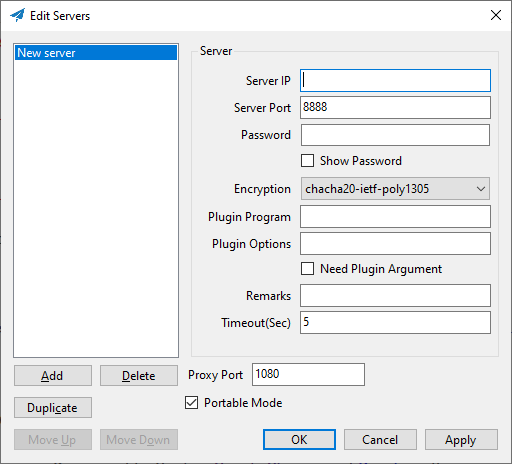
If you have several proxy servers, you can click the Add button to add more proxy servers. Note that you use only one proxy server at a time.
Step 4: Configure Web Browser to Use the Socks Proxy
To make your program use a socks proxy, the program must support socks proxy. Programs like Firefox, Google Chrome and Dropbox allows users to use proxy. I will show you how to configure Firefox and Google Chrome.
Firefox
In Firefox, go to Edit > Preferences > General (or Tools -> Options -> General). Then scroll down to the bottom and click Settings in Network Proxy. In the Connection Settings window, select manual proxy configuration. Then select SOCKS v5 because Shadowsocks is a Socks5 proxy. Enter 127.0.0.1 in the SOCKS Host field and 1080 in the port field. Make sure Proxy DNS when using SOCKS v5 is enabled. Click OK to apply these modifications.
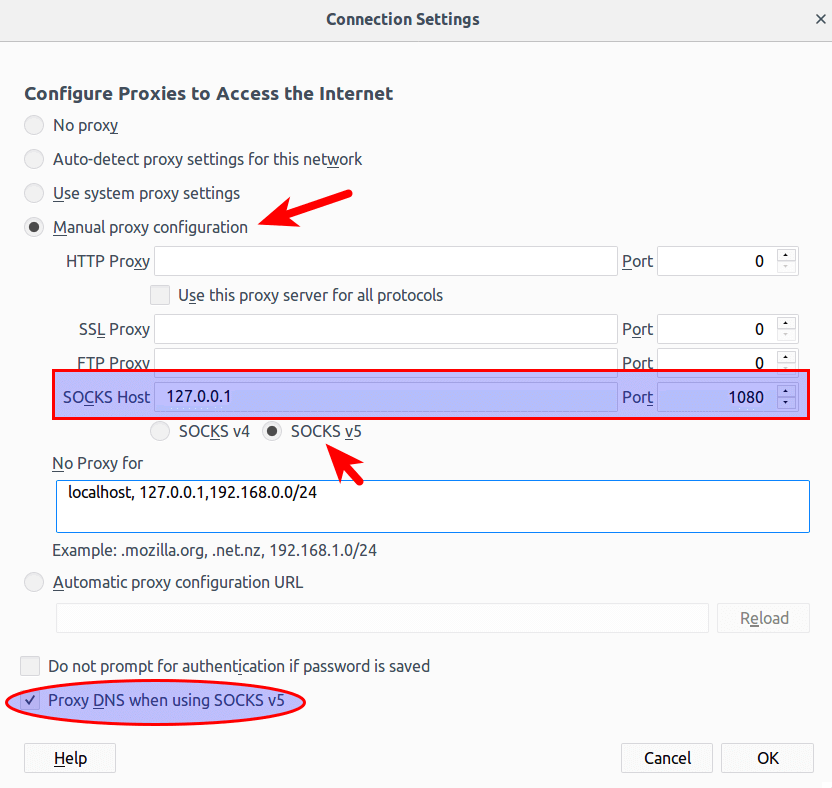
Now Firefox will connect to the local Shadowsocks client which is listening on 127.0.0.1:1080, then the traffic will be routed through the Shadowsocks-libev server.
Google Chrome
While you can configure proxy for Google Chrome and Chromium browser from the command line, I recommend installing the Proxy SwitchyOmega extension to manage proxies.
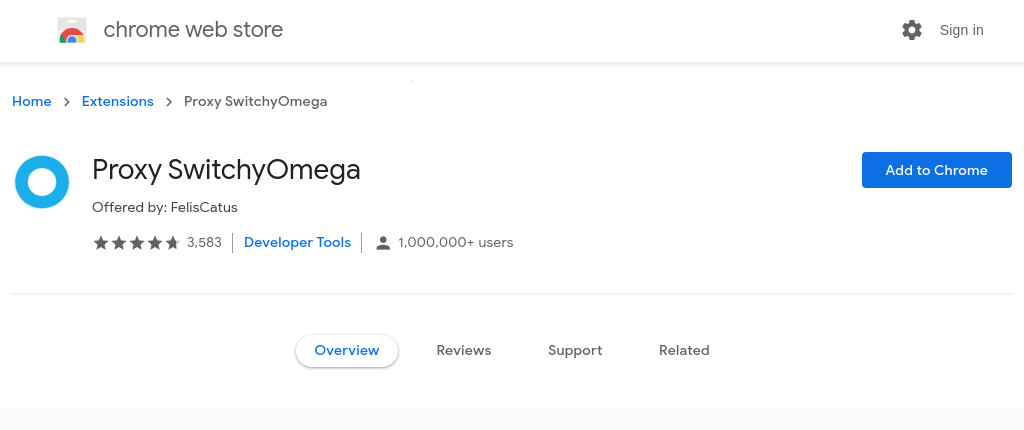
Once the extension is installed in Google Chrome, configure a proxy server as follows:
- Choose the
SOCKS5protocol. - Set
127.0.0.1as the server address. - Set
1080as the port number.
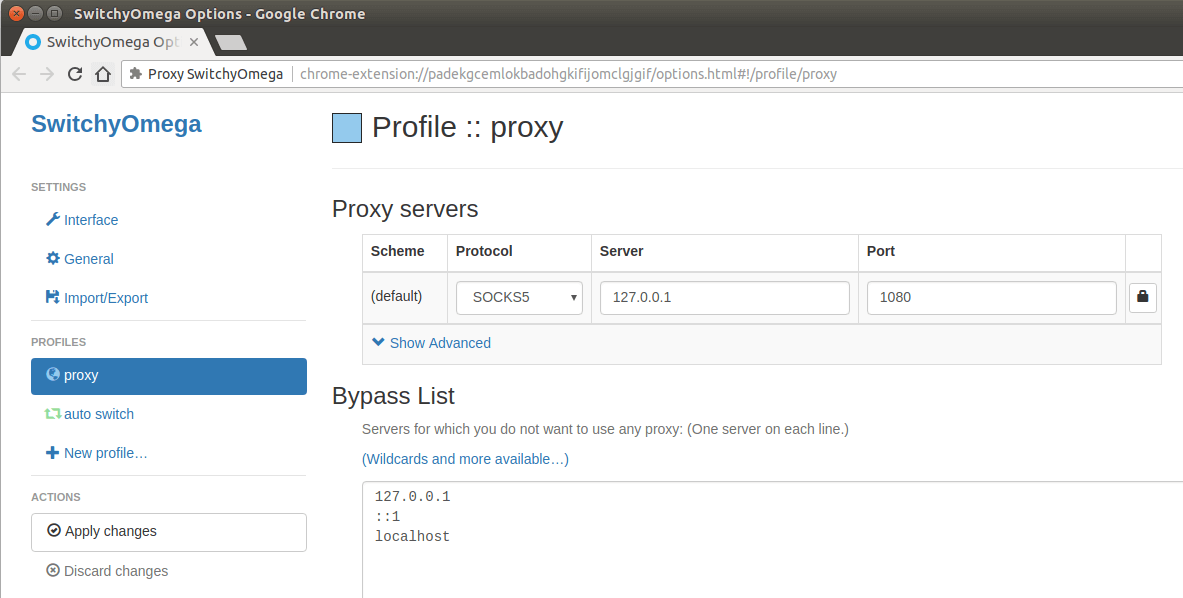
Apply the changes. Then click the extensions icon on the upper-right corner and click Proxy SwithyOmega.
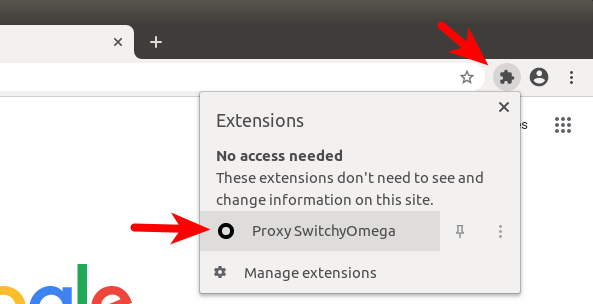
By default, SwithyOmega uses the operating system’s proxy settings. We need to change it from system proxy to proxy.
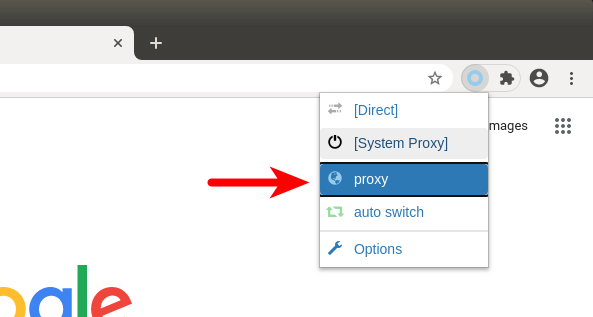
Now Google Chrome will connect to the local Shadowsocks client which is listening on 127.0.0.1:1080, then the traffic will be routed through the Shadowsocks-libev server.
Step 5: DNS Leak Test
Go to dnsleaktest.com. You will see your Shadowsocks server’s IP address, which indicates that your proxy is working.
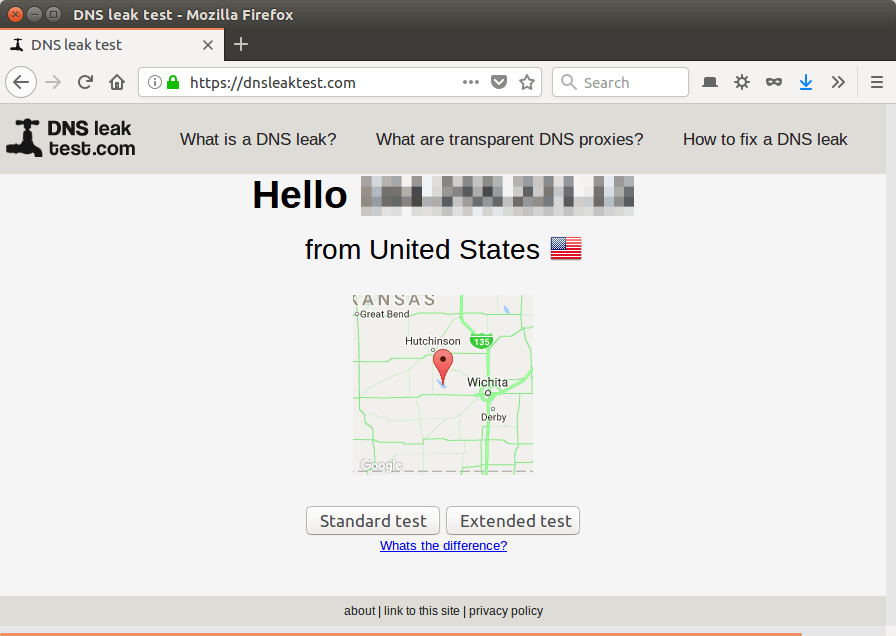
Click the Standard test. Make sure your local ISP isn’t in the test results.

Enable TCP Fast Open
You can speed up Shadowsocks by enabling TCP fast open. TCP is a connection-oriented protocol, which means data can only be exchanged after a connection is established, which is done via the three-way handshake. In other words, traditionally, data can only be exchanged after the three-way handshake is complete. TCP fast open (TFO) is a mechanism that allows data to be exchanged before three-way handshake is complete, saving up to 1 round-trip time (RTT).
TCP fast open support is merged to Linux kernel since version 3.7 and enabled by default since version 3.13. You can check your kernel version by running:
uname -r
To check TCP fast open configuration on your CentOS server, run
cat /proc/sys/net/ipv4/tcp_fastopen
It can return 4 values.
- 0 means disabled.
- 1 means it’s enabled for outgoing connection (as a client).
- 2 means it’s enabled for incoming connection (as a server).
- 3 means it’s enabled for both outgoing and incoming connection.
All my CentOS VPS (Virtual Private Server) returned 1 after running the above command. We want tcp_fastopen set to 3 on our server. To achieve that, we can edit the sysctl configuration file.
sudo nano /etc/sysctl.conf
Then paste the following line at the end of the file.
net.ipv4.tcp_fastopen=3
Reload sysctl settings for the change to take effect.
sudo sysctl -p
Then you will also need to enable TCP fast open in Shadowsocks server configuration file.
sudo nano /var/snap/shadowsocks-libev/common/server-config.json
Add the following line.
"fast_open": true
So your Shadowsocks server configuration file will look like this:
{
"server":["[::0]", "0.0.0.0"],
"mode":"tcp_and_udp",
"server_port":8888,
"local_port":1080,
"password":"o+4LmywwopNXSUhA7Wf8wg==",
"timeout":60,
"name_server":"8.8.8.8",
"method":"chacha20-ietf-poly1305",
"fast_open": true
}
Note that the last config line doesn’t end with comma. All other lines in the {...} block should end with comma. Save and close the file. Then restart Shadowsocks server.
sudo systemctl restart shadowsocks-libev.service
Check if it’s running. (An error in the configuration file can prevent it from restarting.)
systemctl status shadowsocks-libev
You also need to edit the Shadowsocks client configuration file and restart it to enable TCP fast open on CentOS desktop.
Enable TCP BBR
TCP BBR is a TCP congestion control algorithm that can greatly improve connection speed. To enable it on CentOS server, edit /etc/sysctl.conf file.
sudo nano /etc/sysctl.conf
Add the following two line at the end of the file.
net.core.default_qdisc=fq net.ipv4.tcp_congestion_control=bbr
Save and close the file. Then reload sysctl configurations.
sudo sysctl -p
Now check the congestion control algorithm in use.
sysctl net.ipv4.tcp_congestion_control
Output:
net.ipv4.tcp_congestion_control = bbr
Congrats! You have successfully enabled TCP BBR on CentOS server.
Wrapping Up
That’s it! I hope this tutorial helped you install Shadowsocks-libev proxy on CentOS. As always, if you found this post useful, then subscribe to our free newsletter to get more tips and tricks 🙂
Shadowsocks is a forward proxy. Want to know what’s a forward proxy? Please read the following article:


